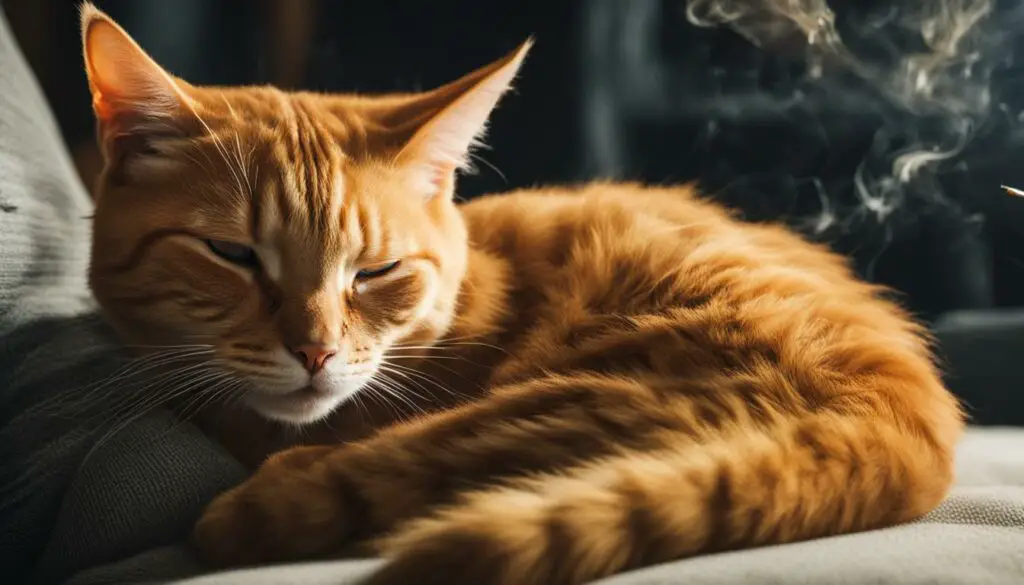Have you ever found yourself asking, “Why did my cat pee on me?” It can be both confusing and frustrating when your beloved furry friend exhibits this behavior. In order to address and prevent this issue, it’s important to understand the underlying reasons behind it. Cats may pee on their owners for various reasons, including marking territory, experiencing stress or anxiety, or having medical issues. By gaining insight into these factors, you can take the necessary steps to address the behavior effectively.
Key Takeaways:
- Understanding the reasons behind why cats pee on their owners is crucial for addressing the behavior effectively.
- Common reasons include marking territory, stress or anxiety, and medical issues.
- Creating a safe and secure environment, providing proper litter box hygiene, and seeking veterinary assistance when necessary are essential for resolving the issue.
- Behavior modification techniques, environmental enrichment, and establishing a supportive routine can help prevent future incidents.
- Building a strong bond with your cat through effective communication and understanding is key to addressing and preventing inappropriate urination behaviors.
Marking Territory: Why Cats Use Urine to Claim Ownership
When a cat pees on their owner, it may be a sign of marking territory and establishing ownership. Cats have scent glands in their urine, which they use to communicate with other cats and claim their territory. This behavior is more common in unneutered male cats, but it can also occur in neutered cats. It is important to understand why cats engage in this behavior and how to address it effectively.
One reason cats may pee on their owners is to assert their dominance and mark their territory. Cats have a highly developed sense of smell, and their urine contains pheromones that are unique to them. By urinating on their owner, cats leave their scent and establish ownership over their human companion. This behavior can also be triggered by changes in the environment or the addition of new family members, as cats may perceive these changes as a threat to their territory.
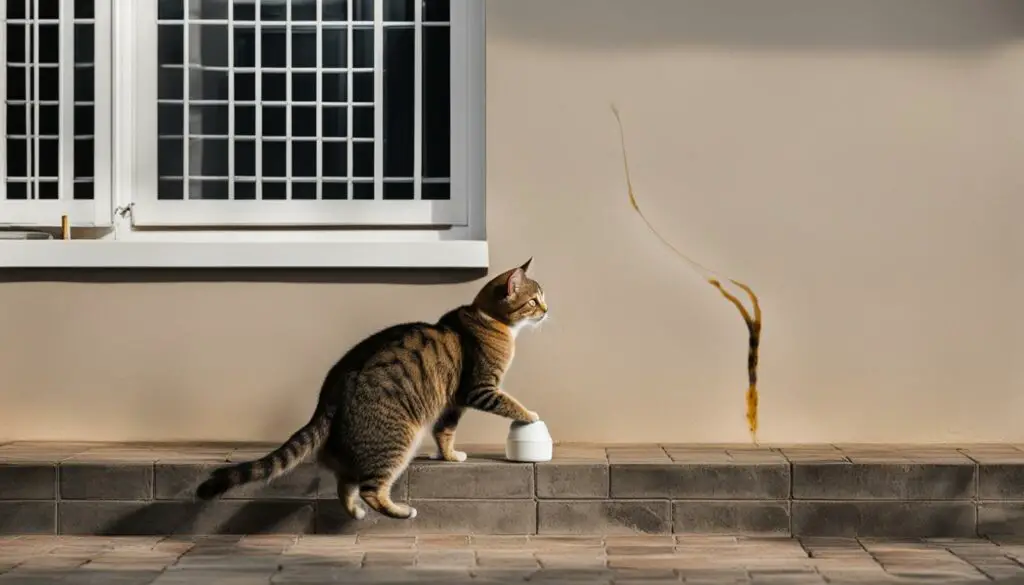
To understand why a cat is peeing on their owner, it is important to consider the familiar smell. Cats are highly sensitive to scents and rely on familiar smells to feel secure. If the cat detects unfamiliar scents on their owner, such as those of other animals or even different people, they may feel the need to reassert their ownership by urinating on them. This behavior is a way for cats to communicate and establish boundaries within their social group.
If you find yourself in this situation, it is important to address the underlying cause and provide appropriate solutions. This may include implementing behavior modification techniques, such as creating a safe and secure environment for your cat, providing multiple litter boxes in different areas of the house, and using positive reinforcement to encourage desired behavior. Seeking veterinary assistance can also help rule out any medical causes and provide additional guidance.
Stress and Anxiety: A Common Cause of Inappropriate Urination
Stress and anxiety can be significant factors contributing to cats peeing on their owners. Cats are sensitive creatures, and changes in their environment or routine can trigger feelings of stress and anxiety. This can lead to inappropriate urination as a way for cats to cope with their emotions. Understanding and addressing these underlying issues is essential in helping cats overcome this behavior.
Changes in routine, such as moving to a new home or introducing a new family member or pet, can cause stress and anxiety in cats. They may feel overwhelmed or threatened by these changes, leading to urination outside of the litter box. The use of anti-anxiety products, such as pheromone diffusers or calming supplements, may help reduce stress levels and alleviate inappropriate urination behaviors.
“Stress and anxiety can cause cats to urinate in inappropriate places, including on their owners.”
Creating a calm and peaceful environment for your cat can also help reduce stress and anxiety. Providing a quiet and safe space for your cat to retreat to can give them a sense of security and help alleviate their emotional distress. Additionally, maintaining a consistent routine and spending quality time with your cat can help strengthen the bond between you and provide a sense of reassurance.
Reducing stress and anxiety in cats:
- Keep a consistent routine and avoid sudden changes
- Provide a safe and quiet space for your cat
- Use anti-anxiety products, if necessary
- Spend quality time with your cat to strengthen the bond
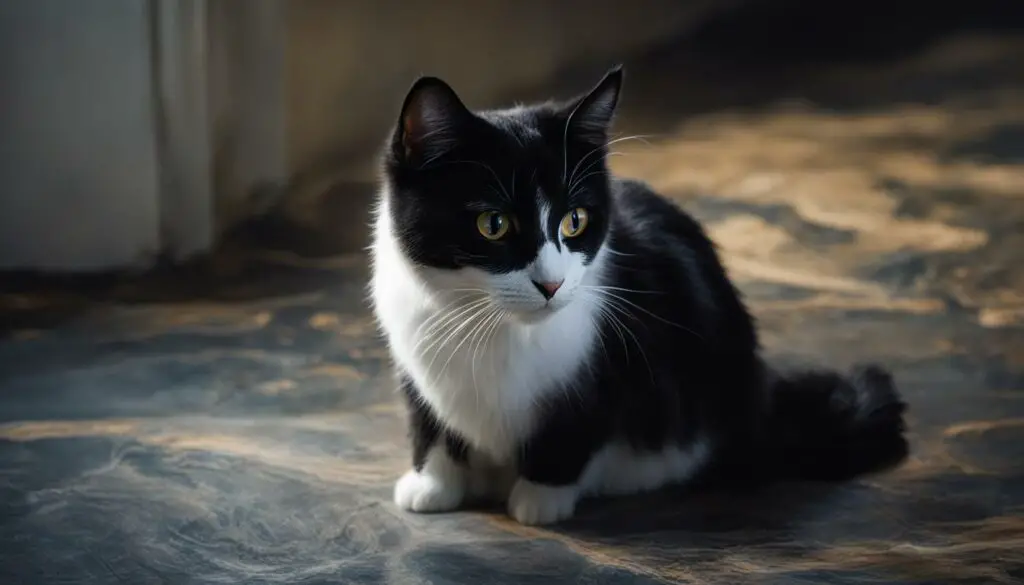
By addressing the underlying stress and anxiety in cats, it is possible to reduce or eliminate inappropriate urination behaviors. Recognizing the signs of stress and providing appropriate support and care can help create a positive and harmonious environment for both the cat and the owner.
Fear and Insecurity: Peeing on Owners as a Sign of Vulnerability
When cats exhibit the behavior of peeing on their owners, it can often be a sign of fear and insecurity. Cats may avoid using their litter box if they perceive it as a place of vulnerability and instead seek the company and comfort of their owner, resulting in urination on their owner. To address this issue, it is crucial to create a safe and secure environment for the cat, ensuring that they feel comfortable using their litter box and have access to it without fear or anxiety.
Creating a safe environment involves providing a quiet and secluded area for the litter box, away from loud noises or high-traffic areas. Additionally, ensuring that the litter box is cleaned regularly and maintained in a hygienic condition will help encourage the cat to use it consistently. Cats are naturally clean animals and will avoid using a dirty or smelly litter box.
In cases where a cat exhibits severe fear or insecurity, it may be beneficial to consult with a professional feline behaviorist or veterinarian. These experts can provide guidance on behavior modification techniques and offer tailored advice to address the specific issues causing the cat’s fear and insecurity. By identifying and addressing the root causes of fear and insecurity, owners can help their cats feel more confident and reduce the likelihood of urinating on them.
Creating a Safe and Secure Environment
To create a safe and secure environment for your cat, consider implementing the following measures:
- Provide a quiet and secluded area for the litter box
- Clean the litter box regularly to maintain hygiene
- Avoid placing the litter box in high-traffic or noisy areas
- Use pheromone diffusers or calming products to reduce anxiety
- Ensure the cat has a designated safe space, such as a cat tree or hiding spot
By implementing these measures and addressing the underlying fear and insecurity, you can create a safe and secure environment that encourages appropriate litter box usage and reduces the likelihood of your cat peeing on you.
| Signs of Fear and Insecurity in Cats | Signs of a Safe and Secure Environment |
|---|---|
| – Hiding or avoiding social interactions | – Relaxed body posture and confident behavior |
| – Increased vocalization or aggression | – Consistent use of the litter box |
| – Excessive grooming or self-directed aggression | – No signs of inappropriate urination |
Creating a safe and secure environment is essential for cats to feel comfortable and confident in using their litter box. By addressing fear and insecurity, owners can build a stronger bond with their cats and eliminate the issue of inappropriate urination.

Section 5: Medical Reasons: Identifying and Addressing Potential Health Issues
When it comes to cats peeing on their owners, medical causes can be a significant factor. Conditions such as cystitis, urinary tract infections, and bladder or kidney problems can lead to increased urgency to urinate or urination outside of the litter box. Additionally, cats may experience pain or discomfort that hinders their ability to use the litter box properly.
To address these medical causes, it is crucial to consult a veterinarian who can perform a thorough evaluation. This evaluation may include tests to rule out any underlying health issues and identify the appropriate treatment. The veterinarian can prescribe medication to alleviate pain or antibiotics to treat infections, providing relief for the cat and potentially resolving the inappropriate urination behavior.
| Medical Causes | Symptoms | Treatment |
|---|---|---|
| Cystitis | Painful urination, frequent urination, blood in urine | Pain medication, anti-inflammatory drugs, diet changes |
| Urinary Tract Infection | Frequent urination, straining to urinate, blood in urine | Antibiotics, increased water intake |
| Bladder or Kidney Problems | Increased frequency of urination, noticeable discomfort | Medication, fluid therapy, dietary changes |
Incontinence can also be a medical cause for cats peeing on their owners. It is important to consult a veterinarian to determine the underlying cause of the incontinence and explore potential treatment options, such as medication or surgery if necessary.
By identifying and addressing any medical causes, owners can help their cats overcome the inappropriate urination behavior and provide them with the necessary relief and comfort.
Litter Box Issues: Ensuring Optimal Hygiene and Accessibility
When it comes to addressing inappropriate urination behaviors in cats, litter box issues can play a significant role. Cats are known for being particular about their litter boxes, and ensuring optimal hygiene and accessibility is essential for preventing them from peeing on their owners.
A clean litter box is crucial to encourage proper litter box usage. Cats have a keen sense of smell and may avoid using a dirty or smelly litter box. Regularly scooping out waste and replacing soiled litter can help maintain cleanliness and prevent unpleasant odors.
Additionally, providing multiple litter boxes can be beneficial, especially in multi-cat households. Having more than one litter box ensures that each cat has easy access to a clean and private space. It also helps prevent territorial disputes and reduces the likelihood of cats peeing on their owners as a form of marking territory.
| Litter Box Hygiene Tips | Litter Box Accessibility Tips |
|---|---|
| • Regularly scoop out waste | • Place litter boxes in quiet and easily accessible areas |
| • Replace soiled litter | • Avoid placing litter boxes near noisy or busy areas |
| • Clean litter boxes with mild soap and water | • Provide multiple litter boxes in multi-cat households |
| • Avoid using strong-smelling cleaning agents | • Ensure litter boxes are easily accessible for elderly or disabled cats |
| • Consider using odor-neutralizing litter | • Choose litter boxes with low sides for kittens or senior cats |
By prioritizing litter box hygiene and accessibility, cat owners can create a favorable environment that encourages proper litter box usage and significantly reduces the likelihood of cats peeing on their owners.
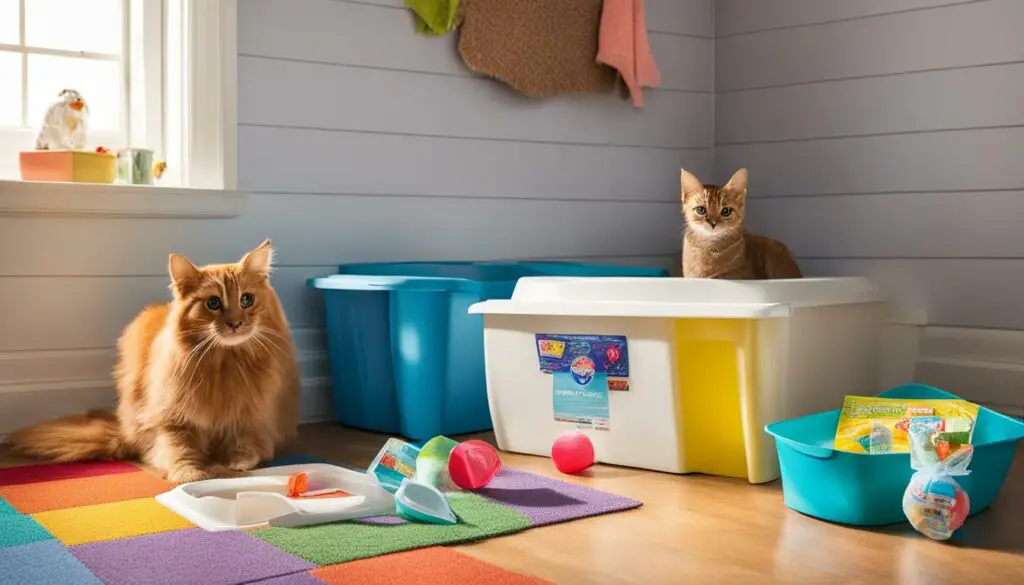
Behavior Modification: Establishing a Positive and Safe Environment
When it comes to addressing inappropriate urination in cats, behavior modification techniques can be highly effective. By establishing a positive and safe environment, we can help our feline friends develop desirable litter box behaviors. Positive reinforcement is a key aspect of behavior modification, where we reward good behavior and create positive associations with using the litter box correctly.
It’s important to remember that punishment or reprimanding the cat for inappropriate urination can actually worsen the behavior and increase stress and anxiety. Instead, we focus on encouraging and rewarding the desired behavior. For example, when the cat uses the litter box, we can provide treats, praise, or playtime as a positive reinforcement.
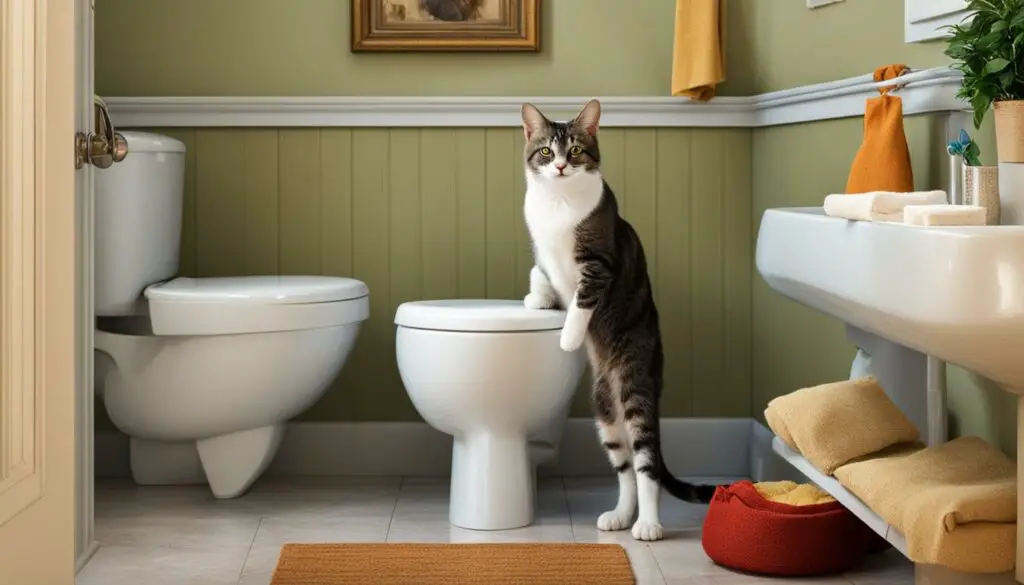
In addition to positive reinforcement, there are other techniques that can help discourage inappropriate urination. One approach is to make the area where the cat has previously urinated less appealing by using deterrent sprays or placing aluminum foil or double-sided tape in that area. This can help redirect the cat’s attention away from inappropriate locations and encourage them to use the litter box.
H3: Creating a Litter Box Sanctuary
Creating a comfortable and inviting litter box area is essential for behavior modification. Here are some tips:
- Have multiple litter boxes available in different areas of the house, especially in multi-cat households.
- Ensure the litter boxes are easily accessible and located in quiet, low-traffic areas.
- Keep the litter boxes clean and free of unpleasant odors. Scoop them daily and change the litter regularly.
- Choose a litter that your cat prefers. Some cats have preferences for certain types of litter, such as clumping or non-clumping, scented or unscented.
| Behavior Modification Techniques | Benefits |
|---|---|
| Positive reinforcement | Establishes positive associations with using the litter box |
| Deterrent sprays or barriers | Discourages inappropriate urination in specific areas |
| Multiple litter boxes | Ensures accessibility and reduces competition among cats |
| Clean and odor-free litter boxes | Maintains a favorable environment for the cat |
| Choosing the right litter | Meets the cat’s preferences for texture and scent |
By implementing these behavior modification techniques and creating a positive and safe environment, we can help our cats develop healthy litter box habits and reduce instances of inappropriate urination.
Environmental Enrichment: Reducing Stress and Anxiety
Creating an enriching environment for your cat is essential in reducing stress and anxiety, which can contribute to inappropriate urination behaviors. Providing opportunities for playtime, interactive toys, scratching posts, and vertical spaces can help stimulate your cat and engage them in natural behaviors. Playtime not only provides mental and physical stimulation but also strengthens the bond between you and your cat.
Interactive toys, such as puzzle feeders or treat-dispensing toys, can keep your cat mentally engaged and provide a positive outlet for their energy. Scratching posts are crucial for satisfying your cat’s natural instinct to scratch and maintain their claws. They also help redirect their scratching behavior away from furniture and other household items. Vertical spaces, like cat trees or shelves, give your cat a sense of territory and provide them with elevated perches to observe their surroundings.
“Enriching your cat’s environment with interactive toys and vertical spaces not only alleviates boredom but also reduces stress and anxiety.”
Remember to rotate and introduce new toys regularly to keep them fresh and exciting for your cat. Additionally, providing hiding spots, cozy beds, and opportunities for scent marking, such as with strategically placed pheromone diffusers, can help create a secure and comforting environment for your cat.
| Environmental Enrichment | Benefits |
|---|---|
| Playtime | Physical and mental stimulation |
| Interactive toys | Mental engagement and energy outlet |
| Scratching posts | Natural scratching behavior and claw maintenance |
| Vertical spaces | Territory and elevated perches |
Importance of Environmental Enrichment
Providing environmental enrichment for your cat not only reduces stress and anxiety but also promotes their overall well-being. It helps prevent boredom, which can lead to destructive behaviors, and provides your cat with a sense of security and comfort in their environment. By offering a range of stimulating activities and spaces, you give your cat the opportunity to engage in natural behaviors, maintain their physical and mental health, and reduce the likelihood of inappropriate urination.
Seeking Veterinary Assistance: Medical Evaluation and Behavioral Support
When dealing with inappropriate urination behaviors in cats, seeking veterinary assistance is crucial. A veterinarian can provide a comprehensive medical evaluation to rule out any underlying health issues that may be contributing to the behavior. By identifying and addressing any medical causes, such as urinary tract infections or bladder problems, the veterinarian can help alleviate the cat’s discomfort and reduce the likelihood of further inappropriate urination incidents.
In cases where the behavior is primarily behavioral, a qualified feline behaviorist or veterinary behaviorist can offer professional guidance and support. These experts are trained in understanding cat behavior and can help identify the underlying triggers for the inappropriate urination. They can develop a tailored behavior modification plan that addresses the specific needs of the cat and provides strategies to encourage appropriate litter box use.
Additionally, veterinary behaviorists can offer advice on environmental enrichment, which plays a key role in reducing stress and anxiety in cats. They can recommend interactive toys, scratching posts, and other resources that can help keep the cat mentally and physically stimulated. By creating a supportive and enriching environment, owners can help reduce the likelihood of inappropriate urination behaviors in their cats.
Table: Steps to Seek Veterinary Assistance
| Step | Description |
|---|---|
| Step 1 | Identify any potential medical causes |
| Step 2 | Schedule a visit with a veterinarian |
| Step 3 | Discuss the cat’s symptoms and behaviors |
| Step 4 | Undergo a thorough medical evaluation |
| Step 5 | Follow the veterinarian’s recommendations for treatment |
| Step 6 | Consult with a feline behaviorist if necessary |
It is important to remember that each cat is unique, and what works for one may not work for another. Seeking professional advice from a veterinarian or behaviorist can provide the expertise needed to address the inappropriate urination behavior effectively.
By combining medical evaluation, tailored behavior modification, and environmental enrichment, cat owners can give their feline companions the best chance at overcoming inappropriate urination behaviors and maintaining a happy and healthy life.
Preventive Measures to Avoid Future Incidents
In order to prevent future incidents of inappropriate urination in cats, there are several important preventive measures that cat owners should consider. These measures can help maintain the overall health and well-being of their feline companions. By implementing these strategies, owners can create a safe and stress-free environment for their cats, reducing the likelihood of inappropriate urination.
Veterinary check-ups
Regular veterinary check-ups are an essential aspect of preventive care for cats. By scheduling regular visits with a veterinarian, owners can ensure that any potential health issues are detected early on. Routine check-ups can also help address any underlying medical conditions that may contribute to inappropriate urination behaviors. It is important to follow the veterinarian’s recommendations for vaccinations, parasite prevention, and overall health maintenance to keep the cat in optimal health.
Hygiene maintenance
Proper hygiene maintenance is crucial for addressing and preventing inappropriate urination in cats. This includes regularly cleaning and scooping the litter box to ensure that it remains clean and odor-free. Cats are known for their cleanliness and may avoid using a dirty or smelly litter box. By providing a clean and appealing litter box environment, owners can encourage their cats to use the designated area for elimination.
Stress reduction techniques
Reducing stress is key to preventing inappropriate urination in cats. Cats are sensitive creatures and can be easily stressed by changes in their environment or routine. To minimize stress, owners should provide a stable and predictable environment for their cats. This can involve maintaining a consistent daily routine, providing enrichment activities such as interactive toys and vertical spaces, and creating a designated area for the cat to retreat to when they feel overwhelmed. Additionally, incorporating stress reduction techniques such as pheromone diffusers or calming supplements can help alleviate anxiety and promote a sense of calm.
Table: Preventive Measures Checklist
| Preventive Measure | Description |
|---|---|
| Veterinary check-ups | Schedule regular visits with a veterinarian to address any underlying health issues or medical conditions. |
| Hygiene maintenance | Regularly clean and maintain the litter box to provide a clean and appealing elimination area for the cat. |
| Stress reduction techniques | Implement stress reduction techniques such as maintaining a stable environment, providing enrichment activities, and using calming products if necessary. |
By following these preventive measures, cat owners can proactively address and minimize the risk of inappropriate urination behaviors in their feline companions. Taking a proactive approach to cat care can help ensure a harmonious and enjoyable relationship between owners and their cats.
Training and Reinforcement: Encouraging Desired Behavior
When it comes to addressing inappropriate urination in cats, training and reinforcement techniques can play a crucial role. By establishing positive associations with the litter box and using consistency as a key principle, owners can encourage their cats to exhibit desired behavior.
One effective method is to provide rewards or treats when the cat uses the litter box correctly. This creates a positive association and reinforces the behavior. Consistency is essential in this process, as cats rely on predictability to feel secure. By maintaining a regular schedule for feeding, playtime, and litter box maintenance, owners can help their cats establish a supportive routine.
It’s important to note that punishment or reprimanding the cat for inappropriate urination is not recommended. This can increase stress and anxiety, making the behavior worse. Instead, focus on positive reinforcement and create an environment where the cat feels safe and understood.
Benefits of Training and Reinforcement
Training and reinforcement techniques not only help address inappropriate urination but also strengthen the bond between the cat and the owner. By working together to establish desired behavior, both parties can enjoy a harmonious relationship. Training sessions provide opportunities for interaction and engagement, deepening the understanding between the cat and the owner.
“Training and reinforcement techniques not only help address inappropriate urination but also strengthen the bond between the cat and the owner.”
Consistency is key in training and reinforcement. By maintaining a consistent approach, the cat learns what is expected of them and can respond accordingly. Patience and perseverance are important during this process, as cats may take time to learn and adapt. With dedication and a positive attitude, owners can successfully train their cats to use the litter box appropriately.
| Training and Reinforcement Tips | Benefits |
|---|---|
| Use treats or rewards when the cat uses the litter box correctly | Establishes positive associations and reinforces desired behavior |
| Maintain a regular schedule for feeding, playtime, and litter box maintenance | Creates a supportive routine and reduces stress |
| Avoid punishment or reprimanding the cat for inappropriate urination | Reduces stress and anxiety, fostering a positive environment |
| Be consistent in training and reinforcement techniques | Helps the cat understand expectations and respond accordingly |
Training and reinforcement are valuable tools in addressing inappropriate urination behaviors in cats. By creating positive associations, maintaining consistency, and avoiding punitive measures, owners can successfully encourage desired behavior and strengthen the bond with their feline companions.
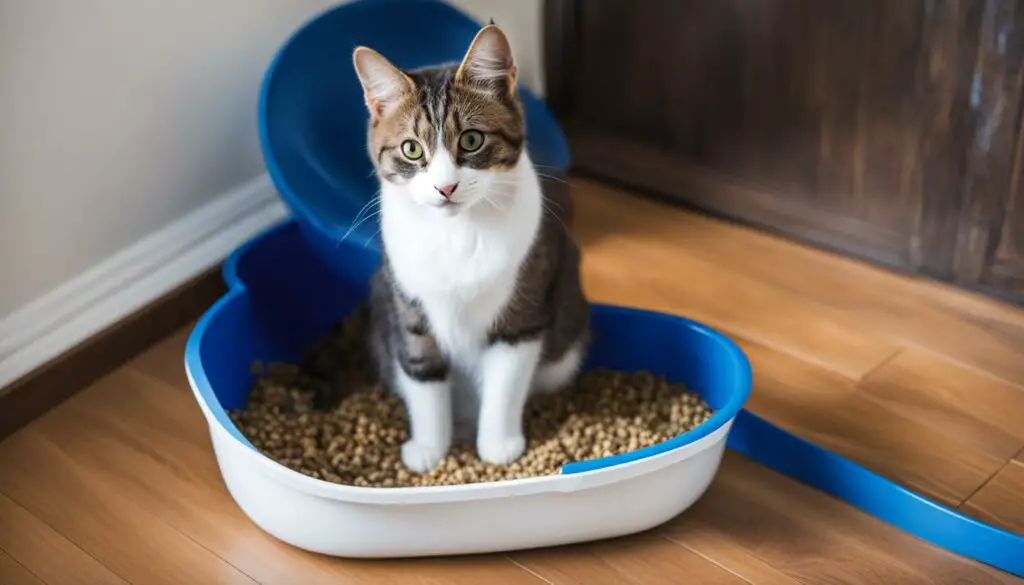
Communication and Understanding: Strengthening the Cat-Owner Bond
Building a strong bond with your cat is crucial in addressing inappropriate urination behaviors. Effective communication and understanding your cat’s needs and behaviors can help create a positive and loving relationship. Providing adequate affection and attention is key to strengthening the bond between you and your feline companion.
Cats are highly sensitive to their environment and can perceive even the slightest changes in your behavior or routine. Taking the time to interact with your cat and engage in activities they enjoy, such as playtime or grooming, can help them feel loved and secure. Remember to respect their boundaries and give them space when needed. By nurturing a loving and understanding connection, you can reduce their anxiety and stress levels, leading to a decrease in inappropriate urination behaviors.
“A cat’s trust and affection grow when they feel understood and valued. By listening to their cues and responding to their needs, you can strengthen your bond and create a harmonious living environment for both of you.”
Creating a Safe and Comfortable Space
Providing a safe and comfortable environment for your cat is essential in strengthening the bond between you. Cats value their personal space and require areas where they can retreat and relax. Designate cozy spots in your home where your cat can rest undisturbed. Consider providing vertical spaces, such as cat trees or shelves, where they can observe their surroundings and feel secure.
Additionally, ensure that your cat has access to a clean and well-maintained litter box. Regularly scoop the litter and change it as needed to maintain optimal hygiene. Cats are particular about cleanliness and may avoid using a dirty litter box, leading to inappropriate urination. By creating a comfortable and inviting space, you are promoting their overall well-being and reinforcing the bond between you and your cat.
The Power of Positive Reinforcement
Positive reinforcement is a powerful tool in strengthening the bond with your cat and encouraging desirable behavior. When your cat uses the litter box appropriately, praise and reward them with treats or affectionate words. This positive association reinforces their good behavior and motivates them to continue using the litter box correctly.
On the other hand, avoid punishing or scolding your cat for inappropriate urination. This can lead to increased stress and anxiety, further exacerbating the problem. Instead, focus on redirecting their behavior to the litter box by providing gentle guidance and positive reinforcement. By using positive reinforcement techniques and creating a loving and supportive environment, you can build a stronger bond with your cat and address inappropriate urination behaviors effectively.

Establishing a Supportive Routine: Consistency and Predictability
Creating a supportive routine is essential when addressing inappropriate urination behaviors in cats. Consistency and predictability play a crucial role in reducing stress and anxiety, helping cats feel secure and confident in their environment. By establishing a regular schedule for feeding, playtime, and litter box maintenance, you can provide a sense of stability that promotes appropriate behavior.
A supportive routine ensures that cats know what to expect, allowing them to anticipate and prepare for daily activities. This predictability helps minimize stress and anxiety, as cats thrive on familiarity and routine. When their environment is consistent, cats are more likely to feel comfortable using their litter box and less inclined to engage in inappropriate urination behaviors.
Consider incorporating a feeding schedule that aligns with your cat’s natural instincts. Cats are crepuscular animals, meaning they are most active during dawn and dusk. By providing meals at these times, you can mimic their natural hunting and feeding patterns, promoting a healthier routine. Additionally, make sure to allocate dedicated playtime to engage your cat’s predatory instincts, allowing for physical exercise and mental stimulation.
When establishing a supportive routine, pay attention to the placement and accessibility of litter boxes. Ensure that litter boxes are easily accessible and located in quiet areas away from high traffic or noisy spots. Cats value privacy and may avoid using their litter box if they feel exposed or vulnerable. Providing multiple litter boxes, especially in multi-cat households, can also help reduce competition and stress.
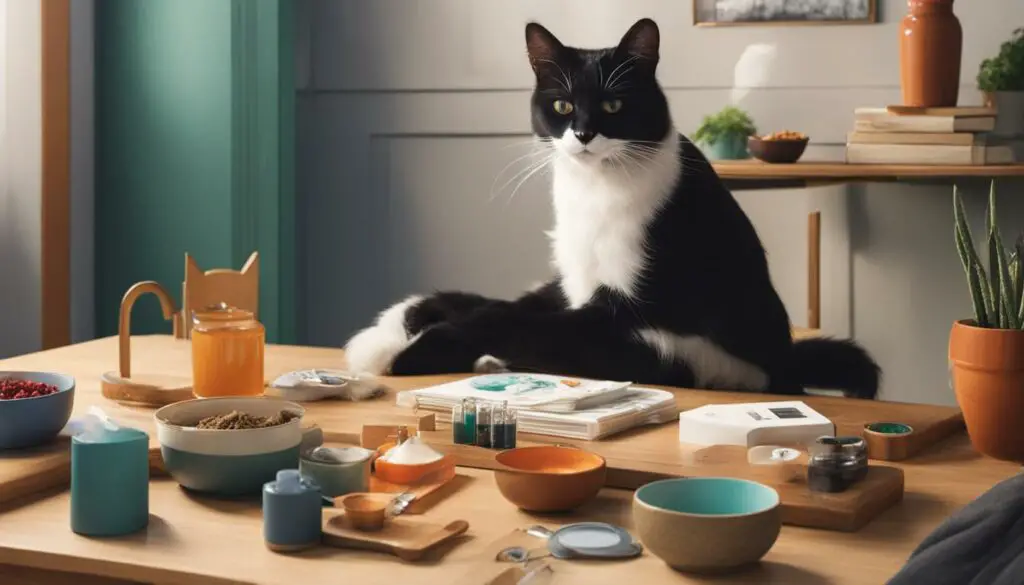
| Key Steps to Establish a Supportive Routine |
|---|
| 1. Set a consistent feeding schedule aligned with natural instincts. |
| 2. Dedicate regular playtime for physical exercise and mental stimulation. |
| 3. Ensure litter boxes are easily accessible and located in quiet areas. |
| 4. Provide multiple litter boxes in multi-cat households. |
A supportive routine built on consistency and predictability is essential for addressing and preventing inappropriate urination behaviors in cats. By incorporating these key steps into your daily schedule, you can create a secure and comfortable environment that fosters appropriate litter box usage.
Conclusion
Inappropriate urination in cats, commonly known as cat pee, can be a frustrating and concerning behavior for pet owners. However, understanding the reasons behind this behavior and implementing appropriate measures can help address and prevent future incidents.
Behavior modification techniques play a crucial role in tackling inappropriate urination. By establishing positive reinforcement and rewarding desired behaviors, such as using the litter box correctly, cats can learn and adapt over time. Consistency is key in training and reinforcement, ensuring a long-term success in modifying their behavior.
Preventive measures are also essential to avoid future incidents. Regular veterinary check-ups help identify any underlying health issues and address them promptly. Maintaining good litter box hygiene, providing a stress-free environment, and implementing stress reduction techniques contribute to preventing stress-related behaviors.
Strengthening the bond between the cat and the owner is vital in addressing inappropriate urination. Effective communication, understanding the cat’s needs, and providing adequate affection and attention create a positive relationship. A supportive routine, with consistency and predictability, contributes to the overall well-being of cats.
In conclusion, by implementing behavior modification techniques, taking preventive measures, strengthening the bond with our cats, and establishing a supportive routine, we can successfully address and prevent inappropriate urination behaviors. Cat owners play a crucial role in creating a harmonious environment that fosters good litter box habits and a strong bond with their feline companions.
FAQ
Why do cats pee on their owners?
Cats may pee on their owners for various reasons, including marking territory, experiencing stress or anxiety, or having medical issues.
How do cats mark their territory through urine?
Cats have scent glands in their urine that help them communicate with other cats and establish their presence. This behavior may be more common in unneutered male cats but can also occur in neutered cats.
What causes stress and anxiety in cats?
Cats can experience stress and anxiety due to changes in their environment or routine, such as moving to a new home or the arrival of a new family member or pet.
Why do cats avoid using their litter box?
Cats may avoid using their litter box if they feel scared or insecure. They may perceive the litter box as a place of vulnerability and seek the comfort of their owner instead.
What medical issues can cause cats to urinate inappropriately?
Cats may pee on their owners if they have medical issues such as cystitis, urinary tract infections, or bladder or kidney problems. These conditions can cause increased urgency to urinate or pain and discomfort.
How can litter box issues contribute to inappropriate urination?
Cats are particular about the cleanliness and accessibility of their litter box. They may avoid using a dirty or smelly litter box or find it difficult to access if it is located in a busy or noisy area.
What techniques can help modify the cat’s behavior?
Positive reinforcement, creating a safe environment, and addressing any underlying issues can help modify a cat’s inappropriate urination behavior. Punishment or reprimanding should be avoided as it can increase stress and anxiety.
How can environmental enrichment reduce stress in cats?
Providing opportunities for play, interactive toys, scratching posts, and vertical spaces can help cats engage in natural behaviors and relieve stress.
When should I seek veterinary assistance for my cat’s inappropriate urination?
It is important to consult a veterinarian if the behavior persists or if there are concerns about the cat’s health. A vet can rule out any underlying issues and provide appropriate treatment or behavioral support.
What preventive measures can I take to avoid future incidents?
Regular veterinary check-ups, maintaining good litter box hygiene, creating a stress-free environment, and implementing stress reduction techniques can help prevent future incidents of inappropriate urination.
How can I encourage my cat to use the litter box?
Training and reinforcement techniques, such as positive associations and consistency, can help encourage desired litter box behavior in cats.
How can I strengthen the bond between my cat and me?
Effective communication, understanding the cat’s needs, and providing affection and attention can help strengthen the bond between a cat and its owner.
Why is a supportive routine important for cats?
Cats thrive on consistency and predictability, so maintaining a regular schedule for feeding, playtime, and litter box maintenance can help alleviate stress and anxiety.

